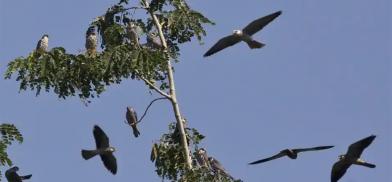Tagged falcons visit India covering 33,000 km before reaching Somalia
Flying thousands of kilometres from their breeding grounds in northern China and eastern Mongolia, nearly a million Amur falcons, a small grey bird of prey, regularly descend across northeast India for nearly a month in October to feed and rest before continuing their journey to southern Africa

Flying thousands of kilometres from their breeding grounds in northern China and eastern Mongolia, nearly a million Amur falcons, a small grey bird of prey, regularly descend across northeast India for nearly a month in October to feed and rest before continuing their journey to southern Africa.
Five Amurs were tagged with satellite transmitters last November in Manipur to identify their important migration routes in remote areas; two of them, who are now considered conservation ambassador for the locals, returned to that area in October after completing their migratory route and covering some 30,000 km.
After spending almost a fortnight in Manipur, both tagged birds headed to their further migration onto the southern parts of Africa by crossing the Arabian Sea.
"The two Amurs that are currently being tracked are named Chiulan and Irang. Chiulan is a male Amur that arrived in Somalia yesterday and Irang is a female Amur and may have also arrived in Somalia now," Suresh Kumar, one of the key researchers, told IANS on Tuesday.
He said they were captured and tagged on October 1, 2019, at Puching village, some 100 km from the state capital Imphal, in Tamenglong district.
Kumar, a senior scientist at the state-funded research institution Wildlife Institute of India, said the male Amur reached Somali after non-stop journey of 5,700 km that includes nocturnal flight.
"The bird named Chiulan reached Tamenglong on October 26 after a roundtrip of 33,000 km. After spending 15 days there, it started its non-stop onward journey on November 11," he said.
During its journey Chiulan, named after a village, crossed several Indian states. It reached Somalia on November 16 at 5.30 p.m. This journey took five days and 13 hours. It crossed he Arabian Sea by covering a distance of 3,000 km.
The Irang bird reached Manipur after a roundtrip of 29,000 km.
Two of the five transmitters installed last year have been working and airing data on their migration routes.
Kumar, who has attached satellite transmitters on 15 falcons in the last seven years, said the scientists now have a better understanding about their migratory routes. This also helps identifying their routes in remote locations.
Each transmitter with a solar-charged battery weighs less than five grams is tagged on an Amur whose weight ranges from 170 to 180 grams.
"The weight of a transmitter should be less than three per cent of the total weight of a bird. If it is slightly heavy, it will impact the natural behaviour of the bird," he explained.
This tagging project was initiated first in Nagaland in November 2013 as an international collaborative effort to create awareness about Amurs among local people, and track its migration.
The 2013 initiative was supported by the Raptors MOU, a global agreement to protect endangered raptors under the UN's Convention on Migratory Species.
The 2016 project in Nagaland and subsequently in Manipur two years later was launched with the support of the Ministry of Environment, Forest and Climate Change.
Kumar has been providing technical support in tagging and tracking Amurs to the Nagaland and Manipur's Forest Department.
He has also been helping creating bird awareness, the major component of the project, in northwestern states that were once known for mass illegal harvesting of Amurs for consumption.
Of the 69 species of raptors known from India, the Amur falcon has been one of the least talked about species till recently.
The Amurs are believed to arrive in their southern African winter range in November-December and depart by early May.
According to the Convention on Migratory Species (CMS), the Amur falcon was targeted at such mass scale in Nagaland in 2012 that it set off a massive outcry among environmentalists across the world.
Praising Kumar for conservation measures, the CMS said by 2013 authorities, religious leaders and youth groups had stepped in to persuade local people to provide safe passage to the birds before continuing their migration from Siberia, China and Mongolia onto the southern parts of Africa.
In the years following, the villagers themselves have adopted measures to punish hunting and to protect the birds' habitat, it added.
Kumar told IANS that mass culling of Amur falcons have been almost stopped through community participation. "Now some stray hunting incidents are being reported mainly from interiors of Nagaland, Assam and Manipur."
(IANS)








Post a Comment